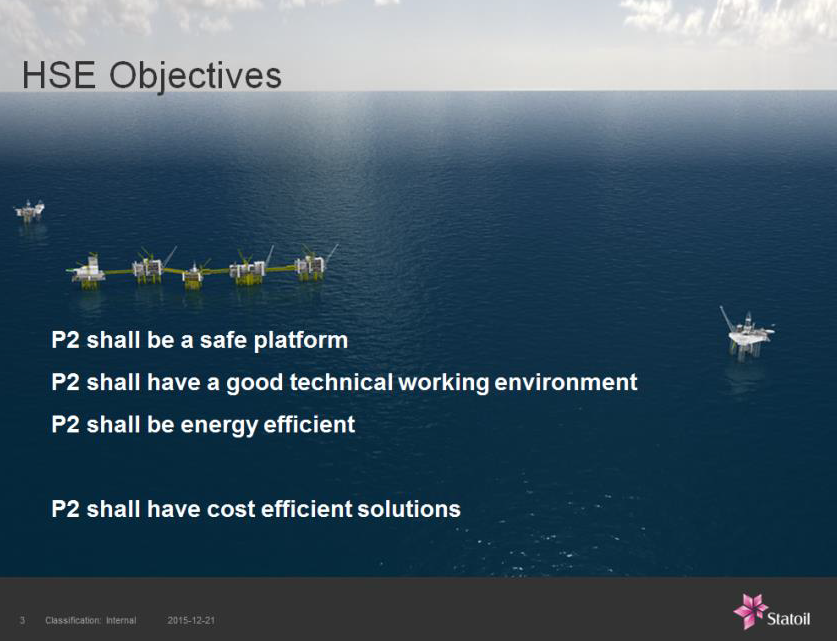The choice of solutions in the field development process has great significance for energy performance in the operational phase. Energy is therefore also an important element before the facility is operational.
The framework for energy efficient operation is determined in the field development process. The more energy efficiency through energy management considered in this phase, the easier and cheaper it will be to achieve energy efficient operation.
Major modification projects can be planned with energy management in mind in the same way as in field development. Minor modifications for energy management can be related to the procurement process.
Investment projects in oil companies are developed according to a Capital Value Process as shown in the figure below. Energy management in design comprises of the steps underlying field development, as shown between DG0 (DG; decision gate) and DG4. These terms may vary from company to company, but the overall process is relatively similar.

![]() What should be done?
What should be done?
A holistic approach to energy management means that the management loop of continuous improvement should begin long before the plant is operational. In practice this means that already under concept choice there is a need for an energy management team to be established established so that one can start the planning and execution of activities to improve energy performance. This would then form the basis for continuing in the management loop to control, correct, and then plan and carry out further activities.
Solution options for new plants are taken with regard to an overarching framework that can seldom be influenced. These conditions are often clarified early in the field development process and are then central to the development of final solutions. The conditions also affect the potential for energy-efficient operation of the facility and include factors such as:
- Area where field development to take place and locally available infrastructure
- Production profile, reservoir strategy and reservoir conditions such as pressure, temperature, etc.
- Economy and risk willingness
- Political guidelines, for example power from shore
Even with these conditions, there are still considerable possibilities for improving energy performance. This opportunity space is dependent on how far the company has come in the field development process. The figure below shows the main activities that have an impact on energy efficient operation and related areas of focus that should be taken into account to achieve optimal solutions.
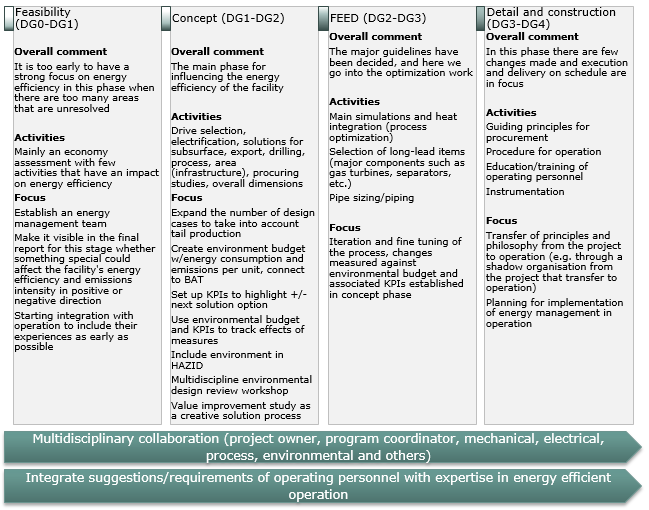
Across the field development process there are also some areas of focus that you should consider to strengthen the work with energy management. An overview is shown below.
| Increased focus on energy management in the field development process can be achieved through |
|---|
Economy and finance:
|
There are a number of studies linked to energy efficiency themes that can be implemented during the field development process. An overview of these is given below, where the check boxes in the columns to the right indicate the relevance of each study in each of the phases in field development.
In addition, there are many specific technology choices that should be considered during the field development process. An overview of these in a format that can easily be used in workshops and brainstorming can be downloaded here (only in Norwegian).
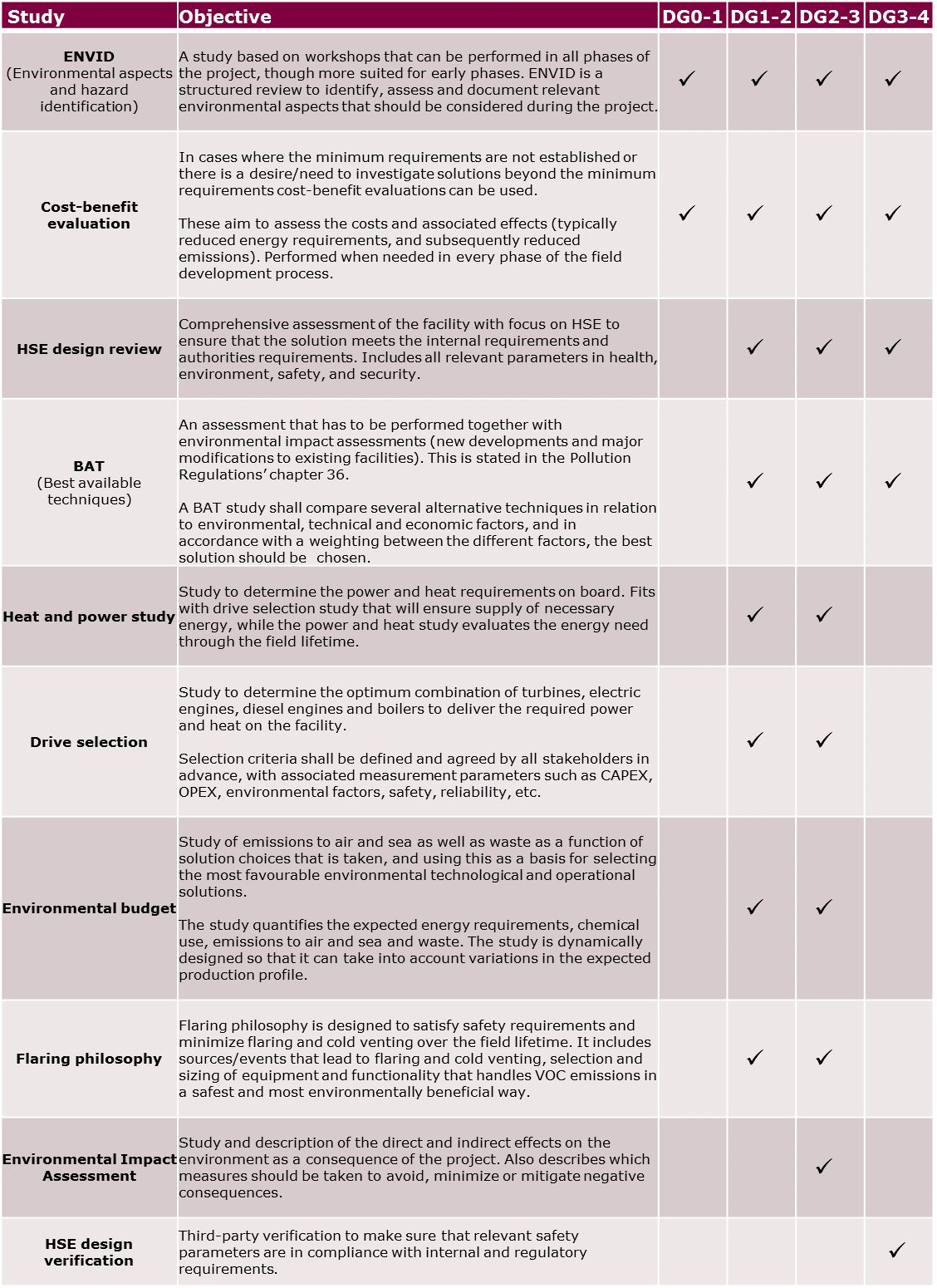
![]() Who should be involved?
Who should be involved?
Project and operational organisations think differently. Yet it is essential that the lessons learned from daily operations can be used in the construction phase of new build projects. The energy manager in the design phase should communicate with energy managers in operations to ensure a good transfer of experience at several levels, including all relevant disciplines.
The figure below shows conceptually the staffing from project and operations through a field development process. There are several examples where operating personnel are involved too late, which results in facilities that "work well in theory". Early and continuous involvement of operating personnel will be essential to achieve a facility that works well in practice.

In addition, the following roles and groups should be included in the efforts to strengthen focus on energy management in field development:
- Management w/project owner and the program coordinator (strategic planning and KPIs)
- Energy team for operations and project
- Multidisciplinary teams in the various field development phases
- Engineers who specify and can set requirements (ordering unit)
- Roles with financial responsibility for operations and project
- Purchasing department
![]() What should be documented?
What should be documented?
The following topics should be documented and updated during the different project phases of a field development process (relevant studies are also listed under "What should be done"):
- Plan for energy management in the field development process
- Results from relevant studies in the field development process, e.g. BAT evaluations
- Documented monitoring linked to energy management, e.g. changes in KPIs through the field development process
![]() Challenges and opportunities
Challenges and opportunities
How can I increase the focus on energy performance in the field development process?
The overall principle in the Capital Value Process is that companies take healthy business decisions. Energy performance is only one of many factors to take into consideration during field development and there are three important factors that could explain why the optimum energy performance until now has not had such great focus: Capex vs. Opex considerations, peak vs. tail production and impact vs. available information. These challenges are further explained below.
Within this opportunity space there are still many energy efficient solutions that do not necessarily entail large expenses, or lead to Capex savings elsewhere. For example, a reduced power requirement will result in smaller equipment and systems, which takes up less space and weigh less. Highlighting these gains in a system perspective over the field life will in that way contribute positively.
Capex vs. Opex
It is often said that energy efficient equipment can entail higher Capex (capital expenditure), which is to be taken again as savings in Opex (operating expenses). Due to high discount rate used in the net present value assessments in oil and gas these savings in Opex are often discounted away.
To illustrate this, the following very simplified example could be considered for a hypothetical platform. It is here assumed a base case facility with associated investment and operating costs. It is further assumed to be an energy efficient case, with moderate added investment of 5 % in Capex to get a more energy efficient facility.
The task is to find the necessary savings in Opex for the energy efficient case, so that the net present value for the base case and energy efficient case is equal (or in favour of energy efficient case), and thus the additional investment in a more energy-efficient construction can be justified.
The calculations and the annual cash flows are illustrated below. If these two cases are to have the same net present value, a 5 % higher Capex must be compensated with a 30 % lower Opex.
Since net present value assessments are still used to assess the feasibility of a project it could be difficult to get more energy efficient equipment implemented, when only based on expected lower operating costs. Highlighting of other benefits is therefore essential. In addition, one can also explore the possibility of funding support from e.g. ENOVA.
| Factor | Assumptions | Base case | Energy efficiency case |
|---|---|---|---|
| Capex | Split over 7 years with 5 %, 5 %, 5 %, 10 %, 15 %, 15 %, 20 % and 25 %, respectively (total of 100 %). | 25 billion NOK | 26.25 billion NOK (5 % larger CAPEX than Base case) |
| Opex | Yearly percentage of Capex, over the facility’s lifetime, 20 years | 2.5 %, i.e. 0.625 billion NOK yearly | For equal net present value, this must be 0.440 billon NOK yearly (30 % lower than Base case) |
| Discount rate | 10 % | 10 % | 10 % |
| Net present value | Equal | 18.95 billion NOK | 18.95 billion NOK |
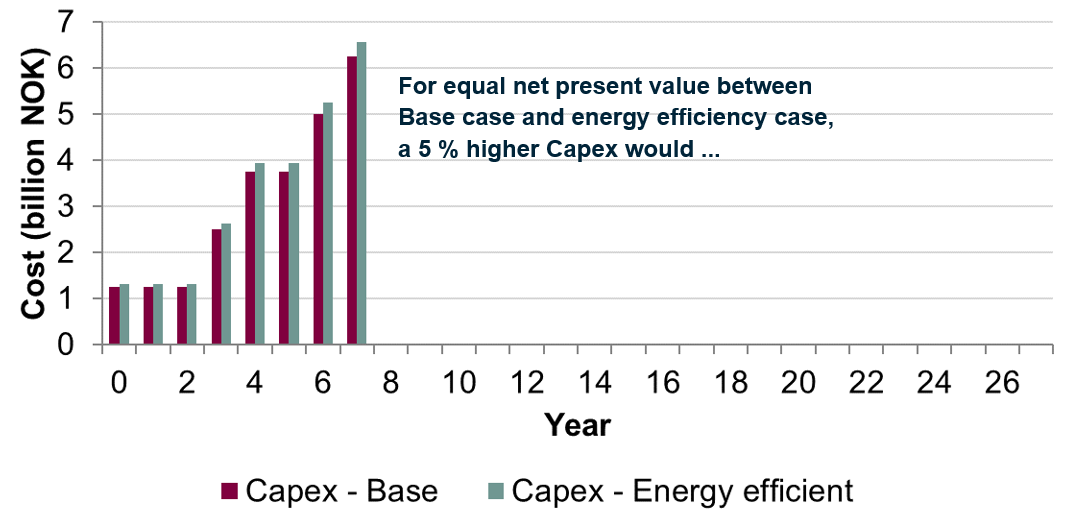

Peak vs. tail production
Upstream oil and gas production is special since facilities are often designed and built for short-term, large peak productions, and then a long tail production where the facility moves ever further away from what it was designed for. As illustrated, in principle, in the figure below the power and heat need is reduced as production decreases.
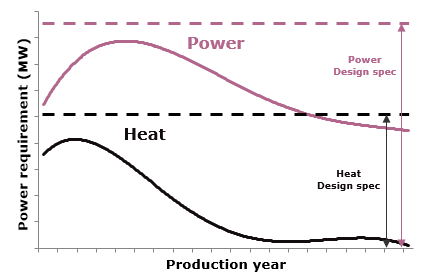
In the tail production the power supply, compressors and pumps will operate at reduced load with decreased efficiency and effectiveness. Increased use of flexible solutions such as variable speed drive, use of modules, taken into account in the design phase, can contribute to keep the efficiency of the facility higher over the field lifetime.
Ability to influence vs. available information
The field development process is characterized by the many decisions that are made with a degree of uncertainty. This is highlighted as a very relevant factor for decisions related to energy performance. The figure below illustrates the problem. Major decisions must be made early while the information base is still thin. Otherwise typical equipment and solutions that are safe are chosen, but that are also unnecessarily robust and oversized.
To get better information earlier is not solved quickly. Iterations on solutions will occur in the early stages anyway, e.g. through value improvement workshops in collaboration with contractors and equipment providers to investigate the opportunities when one yet has time and can afford to make changes.
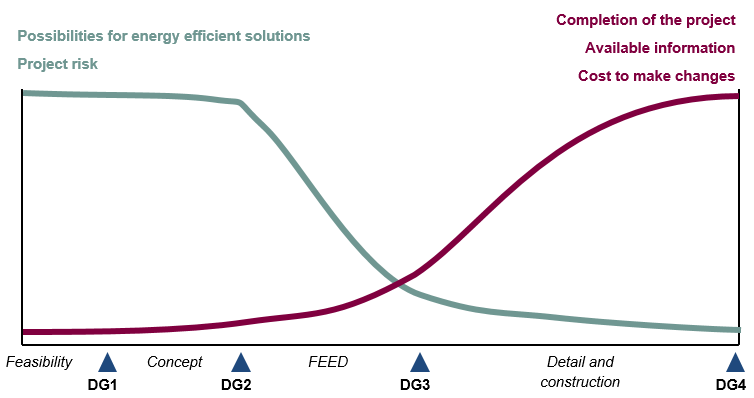
Although energy efficiency is an important topic in our company, our subcontractor (typical EPC contractor) does not focus on this in their deliveries. What can we do?
EPC contractors shall deliver according to the requirements in the contract, including the basis of design. Unless energy efficiency is included here it is hard to ask for an increased focus on this later. The greatest potential for impact is therefore to include energy efficiency as part of the contract; see details under energy management in procurement.
![]() Energy management in practice
Energy management in practice
| An energy efficient Johan Sverdrup |
|---|
|
In their work on Johan Sverdrup Statoil look on following factors as key to achieving an energy efficient facility:
With this they have achieved significant power and heat savings, e.g. reduced heating needs at inlet separator of 14.5 MW, removing or resizing of fire pumps, pumps for condensate heating, emergency generators, etc. An excerpt from the HSE objectives are summarized below:
|
![]() Where do you find this in ISO 50001?
Where do you find this in ISO 50001?
- Chapter 4.5.6 – Design


